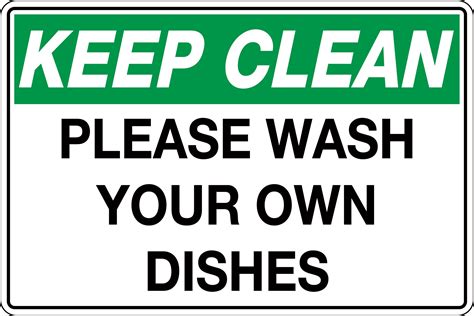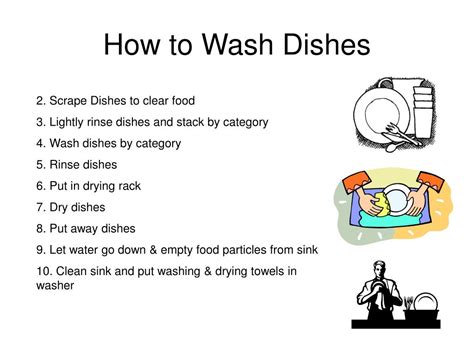Dishes Clean: Simple Guide to Sparkling Results

Dishes Clean: Unveiling the Secrets to Sparkling Results.
Ah, the age-old battle against dirty dishes! It's a chore that none of us can escape, but with the right techniques and a little bit of know-how, achieving sparkling clean dishes can be a breeze. Whether you're a seasoned kitchen veteran or a novice just learning the ropes, this comprehensive guide will arm you with the knowledge and strategies to conquer the dish pile with ease.
Understanding the Dish Cleaning Process

Before we dive into the nitty-gritty, let's break down the fundamentals of dish cleaning. It's not just about scrubbing and rinsing; it's a systematic approach that involves several crucial steps to ensure optimal results.
1. Sorting and Pre-Rinse
The first step in the dish cleaning process is often overlooked, but it's crucial for achieving sparkling results. Sorting your dishes into categories based on their level of dirtiness and material type is essential. This step helps you determine the right cleaning approach and ensures that delicate items aren't damaged.
Begin by separating dishes into three categories: lightly soiled, moderately soiled, and heavily soiled. Lightly soiled items might include plates with minor food residue, while heavily soiled items could be pots and pans with burnt-on food. Sorting ensures you don't overload your sink or dishwasher with an uneven mix, which can lead to less effective cleaning.
Once sorted, give your dishes a quick pre-rinse. This step helps remove loose food particles and prevents them from settling and hardening onto your dishes. A pre-rinse can be done under running water or by filling your sink with warm water and a mild detergent. Gently swish the dishes to loosen any remaining food bits.
2. Choosing the Right Cleaning Method
The next step is deciding on the most suitable cleaning method for your dishes. There are two primary approaches: manual handwashing and using a dishwasher. Each method has its advantages and considerations, so let's explore them further.
Manual Handwashing
Handwashing dishes is a classic method that offers control and precision. It's ideal for delicate items like fine china, crystal, or items with intricate designs that might not withstand the force of a dishwasher. Here's a step-by-step guide to effective handwashing:
- Fill one sink basin with warm water and a squirt of dish soap. The water should be comfortably warm but not scalding.
- Start with the lightly soiled dishes first. Submerge them in the soapy water and gently scrub using a soft-bristled brush or sponge. Avoid using abrasive pads or brushes, as they can scratch the surface of your dishes.
- Rinse each dish thoroughly under running water to remove soap residue. Ensure that no soap remains, as it can leave a filmy residue.
- Dry the dishes with a clean, soft towel or allow them to air dry on a drying rack.
- Repeat the process for moderately and heavily soiled dishes, ensuring you adjust the water temperature and detergent amount as needed.
Using a Dishwasher
Dishwashers are a modern convenience that can save time and effort, especially for busy households. They offer a thorough and consistent cleaning process. However, it's essential to use the right settings and load your dishwasher correctly for optimal results.
- Choose the appropriate wash cycle based on the level of soiling. Heavily soiled items might require a heavier duty cycle with higher water temperatures.
- Load your dishwasher according to the manufacturer's recommendations. Ensure that dishes are not overcrowded and that water can reach all surfaces.
- Use a high-quality dishwasher detergent and consider adding a rinse aid to prevent water spots and improve drying.
- If your dishwasher has a pre-rinse or quick wash cycle, utilize it for lightly soiled items to save water and energy.
- For heavily soiled dishes, consider soaking them in a sink of warm, soapy water before loading them into the dishwasher. This pre-soak can help loosen tough stains and make the dishwasher's job easier.
3. Effective Cleaning Techniques
Now that we've covered the basics, let's delve into some advanced cleaning techniques to tackle specific challenges.
Removing Burnt-On Food
Burnt-on food can be a nightmare to remove, but with the right approach, it can be conquered. Here are some strategies:
- Soak the affected item in a solution of equal parts water and vinegar. Let it sit for several hours or overnight to loosen the burnt residue.
- Use a plastic or wooden scraper to gently scrape away the loosened food. Avoid metal scrapers, as they can scratch your dishes.
- If the burnt-on food is particularly stubborn, try using a paste made from baking soda and water. Apply the paste, let it sit for a few minutes, and then scrub gently.
Dealing with Grease and Oily Residue
Grease and oil can leave a slippery, filmy residue on your dishes. Here's how to tackle it effectively:
- Start by pre-treating greasy items with a grease-cutting dish soap. Let the soap sit on the surface for a few minutes to break down the grease.
- Use a sponge or brush specifically designated for greasy dishes. Avoid using the same sponge for cleaning multiple surfaces, as it can spread germs.
- For heavily greasy items, consider using a commercial degreaser designed for kitchen use. Follow the instructions carefully to ensure safe and effective use.
4. Maintaining Sparkling Results
Achieving sparkling clean dishes is one thing, but maintaining that shine is another. Here are some tips to keep your dishes looking their best:
- Regularly clean your sponges and brushes to prevent the spread of bacteria and germs. Soak them in a solution of water and bleach or run them through the dishwasher.
- Keep your sink and dishwasher clean and free of food residue. Regularly wipe down surfaces and clean out any food traps or filters.
- Consider using a drying agent or drying rack to prevent water spots and promote faster drying. This can help maintain the shine and clarity of your dishes.
- If you notice water spots or film on your dishes, it might be a sign of hard water. Invest in a water softener or use a vinegar rinse to combat this issue.
Conclusion: The Dish Cleaning Mastery

Achieving sparkling clean dishes is an art that requires a combination of technique, organization, and the right tools. By understanding the dish cleaning process, choosing the right cleaning method, and employing effective techniques, you can conquer the mountain of dirty dishes with ease. Remember, a well-organized and efficient dish cleaning routine not only saves time but also ensures your dishes shine brightly.
So, armed with this knowledge, you're now ready to tackle any dish cleaning challenge that comes your way. Happy cleaning, and may your dishes always sparkle like new!
How often should I replace my dishwashing sponges and brushes?
+It’s recommended to replace sponges and brushes every 1-2 months or sooner if they show signs of wear and tear. Regular replacement helps prevent the spread of bacteria and ensures effective cleaning.
Can I use any detergent for handwashing dishes?
+While any mild dish soap will work, it’s best to choose a detergent specifically formulated for handwashing. These detergents are gentle on hands and provide effective cleaning without leaving residue.
What’s the best way to dry dishes after washing them by hand?
+Using a soft, clean towel is the most effective way to dry dishes. Alternatively, you can allow dishes to air dry on a drying rack, ensuring they are placed in a way that promotes even drying.



